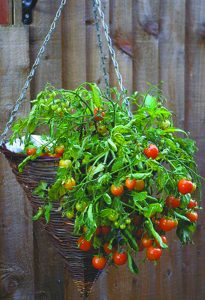July 27, 2018
Yard and Garden: Container Vegetable Gardening
By Richard Jauron and Willy Klein
Iowa State University Extension
Growing vegetables in containers is an easy way to experience the goodness of home-grown vegetables. Most vegetables grow well in containers with adequate sunlight, water and fertilizer, plus a well-drained growing medium. Iowa State University Extension and Outreach horticulturists offer tips to keep plants productive.
For more information, contact the ISU Hortline at (515) 294-3108 or hortline@iastate.edu.
How frequently should I water annuals and vegetables in containers?

Cherry tomatoes growing in hanging basket.
The frequency of watering may vary considerably from container to container. Watering frequency depends on the size and type of container, composition of the potting mix, plant species and weather conditions.
Plants growing in containers should be checked daily (especially in summer) to determine if they need to be watered. If uncertain about the need to water, poke your finger into the potting mix. Water the container when the upper 1 inch of the potting mix is dry. When watering plants in containers, continue to apply water until water begins to flow out the drainage holes in the bottom of the container.
Do not allow the potting mix to dry out completely. Potting mixes shrink and pull away from the sides of the containers when completely dry. Dry potting mixes are difficult to moisten, as water tends to flow between the potting mix and container and then out the bottom of the container (while the potting mix remains dry). Containers that have been allowed to dry out completely should be placed in a tub of water for 20 to 30 minutes to re-moisten the potting mix. Another option is to water the container several times over a period of two or three hours to slowly moisten the entire soil ball.
Should I fertilize annuals and vegetables in containers?
Plants in containers need to be fertilized on a regular basis as nutrient levels in potting mixes quickly fall due to absorption by plants and leaching during watering.
Many commercial potting mixes contain a slow release fertilizer. However, slow release fertilizers usually don’t last the entire growing season. When using a potting mix containing a slow release fertilizer, begin to fertilize plants when plant growth slows or the color of the foliage fades. A granular fertilizer can be applied to the soil surface or plants may be fertilized with a water-soluble fertilizer. Check the product label for application rates and frequency.
What other chores are needed to maintain annuals and vegetables in containers?
In addition to watering and fertilizing, there are a few other chores to maintain annuals and vegetables in containers.
Remove dead leaves and spent flowers on annuals to improve plant appearance and encourage continuous bloom. Pinch back plants that get tall and leggy.
Harvest vegetables at the proper stage of maturity for best quality and to encourage additional production.
Inspect plants on a regular basis for insects and diseases. Control insects by either handpicking or by spraying/dusting with an appropriate insecticide. Control diseases by removing infected leaves or entire plants.
Filed Under: Community
Trackback URL: https://www.50pluslife.com/2018/07/27/yard-and-garden-container-vegetable-gardening/trackback/


